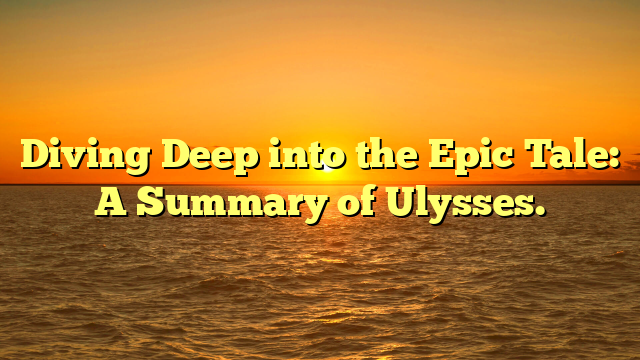The Masterpiece of James Joyce: Ulysses
Breaking with convention and taking the narrative art to an entirely new level, James Joyce’s seminal work, Ulysses, is a marvel of 20th-century literature. It invites a close reading and deep analysis to pull apart every strand of the rich tapestry it so intricately weaves – an exploration that can be both exhilarating and daunting.
The Epic Tale
The novel, which bears the title of the Roman name for Odysseus, plunges the reader into an epic journey through a single day, June 16, 1904, in Dublin, Ireland. There are certain parallels drawn between the Odyssey’s hero and protagonist Leopold Bloom: much like Odysseus, Bloom embarks on a quotidian odyssey across the city, facing his own set of challenges and trials.
Meanwhile, Stephen Dedalus, the semi-autobiographical character borrowed from Joyce’s earlier work, A Portrait of the Artist as a Young Man, is engaged in his own internal journey, striving to make sense of his artistic and personal identity amid the hustle and bustle of life.
Unconventional Narrative
Joyce’s narrative style is ambitious and challenging. He employs an explosive mixture of third-person narrative, interior monologue, omniscient narration, and stream-of-consciousness style. This largely serves to bring out the internal thoughts, memories, and subjective perceptions of characters, transforming even the simplest actions into dense, symbolic events, loaded with potential meanings.
The novel’s famous “Penelope” episode is a prime example of this, where Molly Bloom’s fragmented, punctuation-free soliloquy cascades over 40 pages, offering an intimate peek into her consciousness with poetic eloquence.
Breaking Down Barriers
The linguistic complexity of the novel is further heightened by Joyce’s polymathic erudition and love for multilingual puns and allusions. Its polyphonic text resonates with references to mythology, literature, music, history, religion, and other realms of human knowledge.
Yet, underneath the labyrinthine text and references, Ulysses is eminently a human story. It’s a novel that seeks to blur the boundaries between the everyday and the extraordinary, the banal and the sublime, the physical and the intellectual, celebrating the complexity and diversity of human experience.
Key Takeaways
Even as Ulysses keeps the literary critics and scholars busy with its multifaceted narrative and elusive symbolism, here are some key takeaways for the more casual reader:
1. A Unique Storytelling Style: Ulysses pushes the boundaries of conventional storytelling by adopting an introspective narrative style that brings us to the inner workings of the protagonists’ minds.
2. Everyday Epic: By tracing the ordinary events of a single day, the novel reminds us of the inherent beauty and complexity of everyday life – turning familiar, mundane acts into memorable, heroic ventures.
3. Humanity with Complexity: Joyce’s detailed characterisation illuminates the rich internal lives of individuals often overlooked in literature. It embodies a deep appreciation for the intricate tapestry of human existence.
4. Impact on Modernist Literature: With a distinct narrative style and thematic richness, Ulysses has carved its niche in modernist literature. Its influence is deeply felt in novels that engage with the interiority of characters and those that experiment with form and language.
In conclusion, a dive into the epic tale that is Ulysses is a challenging, yet rewarding journey. Whether you read it cover to cover, or dip in and out of its chapters, the novel promises to captivate its readers with the depth and detail of its exploration into the human psyche.

No responses yet